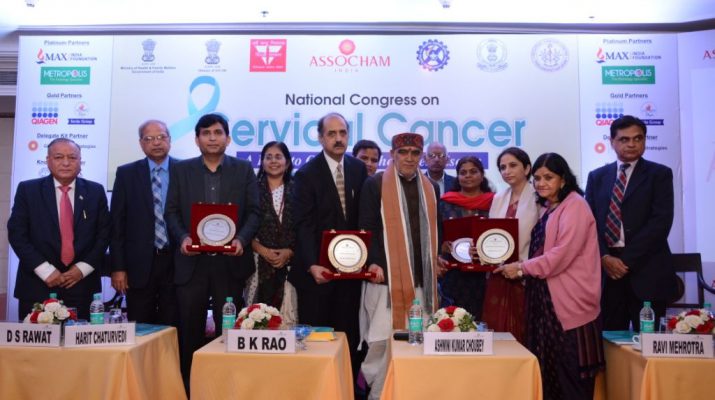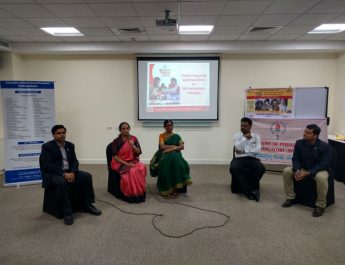The government is mulling public-private partnership (PPP) model cancer detection centers with Tata Trust in states like Bihar, Jharkhand and Chhattisgarh in order to reach out to a larger population, said Mr Ashwini Kumar Choubey, Minister of State for Health & Family Welfare at an ASSOCHAM event held in New Delhi today.About 8.2 million people die due to cancer across the world every year, said Mr Ashwini Kumar Choubey while inaugurating an ASSOCHAM conference on National Congress on Cervical Cancer: A Race to Overcome the Killer Disease.
Dr Sumita Ghosh, Dy. Commissioner (Maternal Health), Ministry of Health & Family Welfare, GoI addressing the conference said that the government has identified nearly 125 centres for mass screening for oral, breast and cervical cancer.
Prof Ravi Mehrotra, Director, National Institute of Cancer Prevention and Research said India has no ambassadors for cervical cancer and our local languages don’t even have a name for it.
 Prof Mehrotra further said that India contributes to nearly one-fourth of the global burden of cervical cancer, with it being the 2nd most common female cancer here in terms of both incidence and mortality. Therefore, researchers emphasized the need for population-based interventions in India to reduce the overall burden of cervical cancer globally. Despite the lack of large scale screening programmes, there was a decline noted in the cervical cancer in urban India. However, the decline was much slower in rural areas.
Prof Mehrotra further said that India contributes to nearly one-fourth of the global burden of cervical cancer, with it being the 2nd most common female cancer here in terms of both incidence and mortality. Therefore, researchers emphasized the need for population-based interventions in India to reduce the overall burden of cervical cancer globally. Despite the lack of large scale screening programmes, there was a decline noted in the cervical cancer in urban India. However, the decline was much slower in rural areas.
The joint study on ‘Cervical Cancer’ prepared by ASSOCHAM-NICPR reveals, India alone has for one fourth of the global burden of cervical cancers1, 2. It accounts for 17% of all cancer deaths among women aged between 30 and 69 years. It is estimated that cervical cancer will occur in approximately 1 in 53 Indian women during their lifetime compared with 1 in 100 women in more developed regions of the world.
There are 29 hospital-based cancer registries and 29 population-based cancer registries (PBCRs) under NCRP. Their data shows that cervical cancer contributes to approximately 6–29% of all cancer in females at different locations within the country. Cervical cancer is the leading site in 6 registry areas viz., Barshi Rural, Barshi Expanded, Mizoram, Tripura, Nagaland and Pasighat PBCRs, adds the study.
The age-adjusted incidence rate of cancer cervix was found to vary widely among registries, highest being 23.07/100,000 in Mizoram State, followed by 22.54/100,000 in Pasighat (Arunachal Pradesh) and the lowest being 4.91/100,000 in Dibrugarh district of Assam. The older PBCRs such as Bengaluru, Bhopal, Chennai, Delhi, and Barshi Rural (Maharashtra) had an age-adjusted incidence rate between 13 and 16/100,000.
More than 85% of patients of cervical cancer were from age group 40 years and above. The maximum numbers of cases were reported in 50–59 years of age group amounting to 27.37% of all cervical carcinoma cases, noted the study.
In developed countries, conventional cytology screening programs have shown a marked decline in the incidence of cervical cancer. It has worked for India as well, but to a lesser extent. In India, although many institutes are involved in cancer screening, but there have been very few coordinated initiatives from public health authorities for prevention and control of cervical cancer at national level.
Cervical cancer is the fourth most common cancer in women and the seventh most common cancer overall. In 2012, worldwide, there were estimated to have been around 528,000 new cases. Around 85% of the global burden occurs in the less developed regions, where cervical cancer accounts for almost 12% of all cancers in females. High-risk regions, with estimated 2012 age-standardized incidence rates of more than 30 cases per 100,000 females, include eastern Africa (42.7 cases), Melanesia (33.3 cases), southern Africa (31.5 cases), and central Africa (30.6 cases). Incidence rates are lowest in Australia/New Zealand (5.5 cases) and western Asia (4.4 cases), highlighted the study.
Cervical cancer remains the most common cancer in women in eastern and central Africa. In contrast to developed countries, cervical cancer is a public health problem in developing countries like India.
The reason for these variations seems to be the lack of preventive and early detection and treatment programmes in low- to middle income countries. Without these interventions, cervical cancer is usually only detected when it is already at an advanced stage when it’s too late for effective treatment, and hence mortality becomes high. Over the last 30 years, cervical cancer incidence and mortality rates have fallen in countries where social and economic status has improved. This seems primarily due to the implementation of secondary prevention measures, like screening, early diagnosis and treatment for pre-cancer and early cancer.




